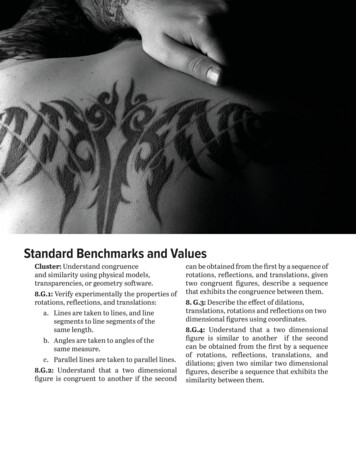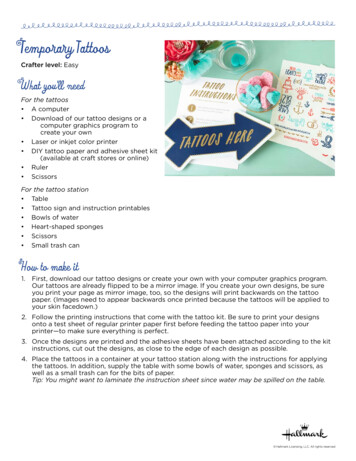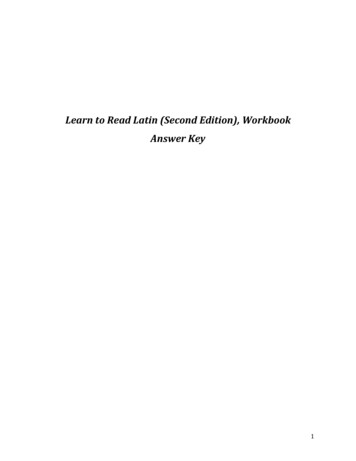
Transcription
Tattoos, American Sailors, and U.S. Maritime Communities, 1860-1945Scott D. BoersmaScott Boersma is a junior history major from Belvidere, Illinois. He wrote the paper for Dr. Charles Foy's HIS:3385: American Maritime History. After graduation Mr. Boersma would like to pursue a master's degree in history.As the United States of America expanded, so did its maritime presence, especially itscommercially and militarily. This expansion led to changes in other maritime-related activities aswell, tattooing being one of them. Over the course of the nineteenth century permanent tattooingparlors popped up in ports around the country, as increasing numbers of sailors looked for asouvenir of their maritime adventures. Early tattoo artists drew inspiration from nature and maritimeachievements. As the world became increasingly interconnected, the popularity of tattoos spread.The growth of tattooing paralleled the development of the United States Navy. In a rapidly changingworld, American sailors in maritime communities from 1860 to 1945, found their identity through aunique tattoo culture.1860: Humble Beginnings in a Mobile IndustryAmericans, whether sailors, those working in land-based maritime trades or living in ports,were not the first to experiment with leaving permanent marks upon the skin. The practice ofmarking the skin dates back thousands of years.1 It fell in and out of style, but in the modern era thepractice was becoming more prevalent in western civilization by 1860. Tribes in the Pacific exposedEuropean and American explorers to the concept of tattooing or marking in the 1700s.2 Thepractice of marking skin would make its way back to European shores on the bodies of sailors. Thisstudy of tattooing among American sailors and in maritime communities begins in 1860 for severalreasons. First, American maritime presence mushroomed in the years after the Civil War. Also, thefirst permanent tattoo parlors in the United States, an important factor in the growth and continuityin tattooing, emerged around 1860. Lastly, European immigration to the United States in the latterhalf of the nineteenth century, changed and diversified the cultural landscape. These three factorscombined and drove the expansion of tattooing among American sailors and maritime communities.The outbreak of the Civil War in 1861 ushered in a new era. The United States federalgovernment, along with the US Navy, devised a plan to blockade the seceding states along a 3,500mile stretch of the American coast. This plan forced the federal navy to begin building up its fleet.3The mobilization of men on both sides of the conflict made for a shared experience in whichtattooing became part of the culture. The earliest recorded professional tattoo artist in America wasMartin Hildebrandt, who claimed to have opened the first shop in 1846, but it is known for certain1 “Facts about tattoos,” Royal Museums Greenwich. National Maritime Museum, accessed November 17, about-tattoos. When Özti the iceman, a 5,000-year-old bronze-age man wasdiscovered in a European glacier in 1991, his skin tissue was so well preserved that researchers were able to identify multiple tattoos.2 Clinton Sanders, Customizing the Body: The Art and Culture of Tattooing (Philadelphia: Temple University Press, 1989), 14.Sanders makes a point to mention modern European tattooing begins with the Cook expedition in the Pacific and the island of Tahiti.3 “The Rise of the American Navy 1775-1914,” History Net. World History Group, accessed November 18, rican-navy-1775-1914.htm. Secretary of the Navy, Gideon Welles started the war with12 warships, 17 steam warships, and only 2 operational steam sloops. In 1861 he would purchase 176 ships and contract another 49 tobe built.100
that he was operating a tattoo business in New York City by 1877.4 Hildebrandt reportedly tattooedthousands of sailors and soldiers, learning his trade from an engraver whom he served with on boardthe USS United States.5 While the testimony of one tattoo artist has questionable validity, there isenough primary evidence to conclude that tattooing members of the American maritime communitywas a widespread practice from the creation of the United States Navy through the Civil War.Seamen’s protection certificates and navy enlistmentreturns issued in the 1790s noted when sailors hadtattoos or other distinguishing body marks.Examination of seamen protection certificates by IraDye led him to conclude that “seafarer tattooingappears to have been fixed and stylized from itsinitial appearance in these records, indicating thatthe custom was well established” by the end of thenineteenth century.6 The practice during the CivilWar can be charted using navy enlistment returns.One such record from 1863 shows Irish immigrantsenlisting into the navy and having their tattoosdocumented as part of official record keeping.7 Theexact reasoning behind an individual’s decision topermanently mark themselves is complicated, but inthe late nineteenth century, individuals lacked formsof universal identification. However, tattooingserved as a source of identification. This could be aleading cause of tattooing in the late 1800s: a bodylacking identification was likely to be placed in anunnamed mass grave.8Tattooing during the late 1800s was still ahighly mobile practice among sailors and the arrivalImage of Samuel O'Reilly's electric tattooing machineof permanent tattoo parlors in ports would soon takesubmitted to the US Patent Office. Source: Patenthold within the coming decades. Hildebrandt’s claimand Trademark Office, Patent No. 464,801.to fame is that he established the first permanenttattoo parlor in the United States, yet there were clearly other individuals also setting up shop inNew York City. These artists would transform the practice, from using crude tools—described as“a queer little instrument made by binding six No.12 needles to the end of a stick as large as a penholder and half as long”—to using electric tattoo machines.9 Samuel F. O’Reilly designed a devicearound 1890 which would quicken the process and decrease the pain involved, while allowing forgreater detail in coloration and shading.10 This technological advance gave greater depth to thedesigns and the number of tattoos an artist could administer grew. These designs included but were“Tattooing as a Fine Art,” Chicago Daily Tribune, October 28, 1877.“Tattooing as a Fine Art,” Chicago Daily Tribune, October 28, 1877.6 Ira Dye, “The Tattoos of Early American Seafarers, 1796-1818" Proceedings of the American Philosophical Society, 133, No. 4(Dec. 1989):528.7 Damian Shiels, “Inked Irishmen: Irish Tattoos in 1860s New York,” Irish American Civil War, accessed May 23, inked-irishmen-irish-tattoos-in-1860s-new-york/.8 Aida Amer and Sarah Laskow, “Tattooing in the Civil War was a Hedge against Anonymous Death,” Atlas Obscura. AtlasObscura, accessed December 5, 2018, ttoos.9 “Tattooing as a Fine Art” Chicago Daily Tribune, October 28, 1877.10 Alan Govenar, “The Changing Image of Tattooing in American Culture, 1846-1966,” in Written on the body: The Tattoo inEuropean and American History, eds. Jane Caplan (Princeton: Princeton University Press, 2000), 21545101
not limited to anchors, crosses, crucifixion scenes, sailors, women, an eagle, coat-of-arms, andnational flags, all early designs that were common among sailors.11 These examples provide an ideaof what designs were being tattooed on sailors’ bodies. The underlying importance of identity andtattoos is clear: these tattoos were “conveying experiences for those around to read, even without averbal exchange taking place.”12 As time progressed, this would still hold true for American sailorsand in maritime communities.1900: The Rise of Tattooingand the Expansion of theNavyBy 1900 there wereconsiderable advances intattooing and the United Statesglobal maritime presence. Theseadvances led to innovativetattooing devices, more tattooartists, permanent parlors, and adistinct culture of tattooing inthe United States. All of thiscame at a time of expandingAmerican military power. Therising nation looked especially toits navy to show the world itsgrowing power. This led to theFrancis B. Johnston. USS Olympia (Cruiser #6) tattooing,establishment of military1899. Library of Congress photo #LC-J698-61327 Lot 8688.epicenters and a distinctMen aboard the USS Olympia look on as the tattooingnationalized maritime cultureprocess is put in practice aboard their ship.within the United States.Tattooing and tattoo parlors became integral parts of these American maritime communities, inlocations such as Chicago, New York City, Norfolk, and San Diego.The turn-of-the century also proved to be a turning point toward a more aggressive UnitedStates foreign policy. In 1898, the United States challenged Spain for dominance in the Caribbeanand the Pacific Ocean. Victory over Spain resulted in United States control over Cuba, Guam, andthe Philippines. Swift victories over Spanish fleets would give the United States a perspective that ithad not experienced before, becoming a rising and formidable naval power on the global stage.13Soaring national pride among sailors led many to commemorate their victories and experiences withtattoos. On a ship stationed in Manilla Bay in 1899, men aboard the USS Olympia lined up for tattoosmemorializing their wartime experiences, according to a fellow sailor. Surviving artwork of tattoodesigns, descriptions of tattoos, and photographic evidence aboard the ship, suggests that thepractice was not limited in its scope.14 A 1898 Chicago Daily Tribune news article notes that expansionof body art inland included Camp Meade in Pennsylvania among other locations. The article“Tattooing as a Fine Art,” Chicago Daily Tribune, October 28, 1877.Louise Moon, “Tattoos, Tars and Sailortown Culture,” Port Towns and Urban Cultures, University of Portsmouth, accessedNovember 30, 2018, n-culture/.13 “The Rise of the American Navy 1775-1914,” History Net. World History Group, accessed November 18, rican-navy-1775-1914.htm. “At the beginning of Roosevelt’s first term, the UnitedStates ranked among the top five naval powers of the pre-dreadnought era.”14 Hope Corse and others, Skin & Bones: Tattoos in the Life of the American Sailor (Philadelphia: Independence SeaportMuseum, 2009), 45.1112102
described how a retired sailor found success in traveling to military installations, tattooing eager andbored servicemen.15 As President Theodore Roosevelt expanded the navy and used it to show theUnited States naval power through the Great White Fleet expedition (1907-1909), the United Statesfurther established far-flung military posts to continue this legacy.Tattoo artists established themselves at military bases and developed their trade. Demand fortattoos skyrocketed among American service men. The navy established the Great Lakes NavalStation in Illinois in 1911, the Norfolk Naval Station in Virginia in 1917, and the San Diego NavalBase in 1922. Naval dockyards, such as San Francisco’s Hunters Point Naval Shipyard and NewYork City’s Brooklyn Navy Yard, also employed thousands of maritime workers. Each of these citiesalready had their own unique maritime culture which mixed with national identities created by thenavy’s expansion. Tattoos became mechanisms for social communication within the complexmaritime communities where these men spent most of their time.16 Tattoo artists often incorporatedaspects of unique local culture into their tattoos. By the early 1900s, Samuel O’Reilly was trainingnumerous artists in New York City to continue the trade. His students made modifications to hispatented electric tattoo machine. As tattooing became faster and easier to perform, more artists wereable to learn the trade, which proliferated the number of tattoos created.While the expansion of tattooing was popular among soldiers, sailors, and those withinmaritime communities, the practice did not go unnoticed by the public. An article in 1902 from theNew-York Tribune notes an interview with a local tattoo artist, “Professor” Elmer Gitchell. Thisarticle demonstrates the growing presence of tattoos within American civilian culture as well as“pushback” against the practice. American society at this time worried about the tattooing ofchildren and hastily made decisions by individuals to permanently tattoo themselves. Yet even asearly as 1902, some tattooists viewed their trade as an art as opposed to simply an income.17Tattooist George Burchett contended that Sutherland Macdonald coined the word tattooist or tattooartist rather than tattooer, explaining “that an artist is a tattoo-ist and only dabblers and low alleyfellows should be described as tattoo-ers.”18 Another article from 1902 claimed that while olderofficers and sailors were adorned with tattoos, younger sailors entering the Navy were resisting thetrend.19 This article underlines a greater issue about social respectability and tattooing. “Therelationship between the popular press and the actual demographics of tattooing in America isunclear,” concluded the article.20 This can lead to a skewed understanding of the actual growth ordecline of the practice among sailors and around the nation. Due to the increased presence oftattooing in the 1940s, with more men in the military during World War II, an argument can bemade that prior to the war, there may have been a decline in tattooing. This was due to reducednaval forces and sailors who likely could not afford tattoos during the Great Depression.21 Still, ifthere was a decrease, the practice was not entirely put to rest among sailors and in maritimecommunities.Comparatively, the tattooing industry witnessed an upturn in Victorian England, wheretattoos became popular among almost all classes—soldier, sailor, aristocrat, and royalty alike.Sutherland Macdonald, an artist much like Samuel O’Reilly in New York City, operated in London“Former Sailor Tattoos the Soldiers,” Chicago Daily Tribune, November 20, 1898.Clinton Sanders, Customizing the Body: The Art and Culture of Tattooing (Philadelphia: Temple University Press, 1989), 20-21.17 “A Tattooing ‘Artist,’” New-York Tribune, October 26, 1902.18 George Burchett, Memoirs of a Tattooist, eds. Peter Leighton (New York: Crown Publishers, 1958), 106.19 “Tattoo Work Decreasing,” The Pacific Commercial Advertiser, November 19, 1902.20 Alan Govenar, “The Changing Image of Tattooing in American Culture, 1846-1966,” in Written on the body: The Tattoo inEuropean and American History, 213.21 Alan Govenar, “The Changing Image of Tattooing in American Culture, 1846-1966,” in Written on the body: The Tattoo inEuropean and American History, 219.1516103
by 1889.22 The most common tattoo consumers for Macdonald were sailors, craftsmen, military andmembers of the aristocracy. Tattooing of royalty also gained the attention of the press. Notablecustomers being Czar Nicholas II of Russia, King George of Greece, King Oscar of Sweden, KaiserWilhelm of Germany, and most male members of the British royal family.23 King George V wouldbe tattooed in 1882 by one of the first famous Japanese artists, Hori Chyo aboard the H.M.SBacchante and King Fredrick of Denmark would be tattooed by the famous British artist, GeorgeBurchett. The exact numbers of tattooed American sailors is unknown, however, tattooing crossedclass lines and created an unspoken social connection through tattoo artists, like Macdonald.1945: The Marked GenerationAllied victory in World War II ended a period of unprecedented and historic growth in theUnited States military and industry due to the war. This growth led to an increased number ofindividuals gaining first-hand experiences on the sea and in maritime communities. In 1939, UnitedStates military personnel numbered 334,473. Six years later that figure stood at 12,209,238.24 In thesame period, the United States Navy’s active ship force expanded from 394 ships in 1939 to astaggering 6,768 in 1945. Through the Second World War, the United States would effectively sendships around the globe, crossing the Atlantic and Mediterranean to defeat Germany in Europe andthe Pacific to combat Japanese imperial expansion.During this period, tattooists enjoyed a wartime boom, as members of the military from allbranches across the United States crowded tattoo parlors. Tattoos spread like wildfire. Patriotictattoos reminiscent of a generation before which would have read “Remember the Maine” now read“Remember Pearl Harbor.” Meanwhile, servicemen also were eager to commemorate their particularbranch of the armed forces: tattoos that read “Happy Landings” were popular among airmen, while“chutes and boots” signified a paratrooper. While most of these men were not life-long servicemen,the same principle of identity applied, as tattoos were a means of establishing bonds and groupsolidarity among platoons, divisions, and branches of government.25 Other popular designsexpressed devotion to family, girls back home, or patriotism.Increasingly, body art became an international business. Even if men missed theiropportunity to get their skin scratched by a tattoo artist in the ports of the United States, tattooistswould be waiting for them in England. Burchett understood what a war meant when it came toEurope in 1939. “I prepared for action. Unlike the folk who feared annihilation from a sky darkenedwith black bombers, I knew exactly what to expect. There would be queues, and one of the biggestwould line up outside my surgery,” he recalled.26 Burchett’s account of tattooing Americans evokesthe idea of “commemorating experiences.” “They are great tourists, even in the middle of a war, andI had many more orders for the Tower of London, Buckingham Palace, London Bridge, Big Ben,Nelson’s Column and any amount of Eros statues from Piccadilly Circus,” he recalled.27 Overall, theacceptance of tattooing remained widespread among servicemen during World War II, a heightnever again experienced on the same scale. Broad acceptance and social approval of body art within22 Jessica Stewart, “Sutherland MacDonald Tattoo History,” My Modern Metropolis, LLC, May 29, 2017, accessedDecember 7, 2018, o-history/.23 Clinton Sanders, Customizing the Body: The Art and Culture of Tattooing (Philadelphia: Temple University Press, 1989), 15.24 “Research Starters: US Military by the Numbers,” National WWII Museum, National WWII Museum, accessed December7, 2018, rters-us-militarynumbers25 Alan Govenar, “The Changing Image of Tattooing in American Culture, 1846-1966,” in Written on the Body: The Tattoo inEuropean and American History, 226.26 George Burchett, Memoirs of a Tattooist, 123.27 George Burchett, Memoirs of a Tattooist, 125.104
the military services can be attributed to patriotism and nationalistic fervor within the UnitedStates.28As the war came to an end, the wartime boom for tattooists also ended. Millions ofAmericans were discharged by the military, and many returned home with permanent souvenirs.Resocialization into civilian life proved difficult for some military men, as their tattoos, which werean important symbol of status in the military, stirred different, sometimes negative, associations athome.29 Changes in American society, such as earlier marriages, larger families, and settling insuburban areas away from cities, ran counter to tattooing culture. New values emphasizedconformity and comfort. Increasingly, tattooing had negative connotation in the United States.30These changes defied many of the rebellious stereotypes associated with tattooing, likely due to itsmaritime heritage. The practice would decline due to these societal changes, but tattooists wouldadjust to the changes in demand as they had done before. The key to success for many tattooists inthis period was staying close to military installations and maritime communities. Designs and styleswhich were heavily influenced by maritime experiences and passed down to their apprentices, can beseen today in the “classic” tattoo revival. Tattoos provided a different sense of identity, but thedesigns of a by-gone era are still being permanently marked on the skin of individuals today.Margo DeMello Inked: Tattoos and Body Art Around the World, vol. 2 (New York: ABC-CLIO, 2014), 413.Alan Govenar, “The Changing Image of Tattooing in American Culture, 1846-1966,” in Written on the Body: The Tattoo inEuropean and American History, 229.30 Alan Govenar, “The Changing Image of Tattooing in American Culture, 1846-1966,” in Written on the Body: The Tattoo inEuropean and American History, 230.2829105
world, American sailors in maritime communities from 1860 to 1945, found their identity through a unique tattoo culture. 1860: Humble Beginnings in a Mobile Industry Americans, whether sailors, those working in land-based maritime trades or living in ports, were not the first to experiment with leaving permanent marks upon the skin. The practice of










